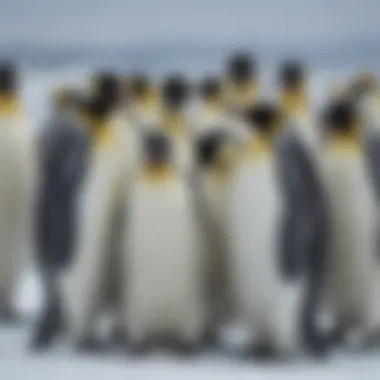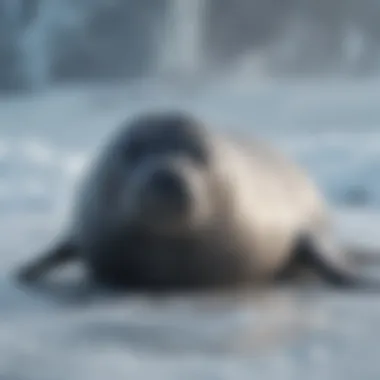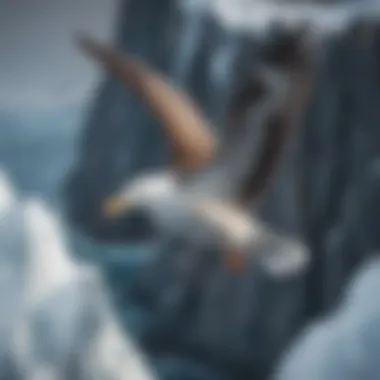Exploring Antarctica's Unique Animal Kingdom


Intro
Antarctica presents itself as one of the most extreme environments on Earth. Despite its harsh climate, a diversity of animal species has adapted to thrive here. Understanding these animals is crucial, not just for the sake of knowledge, but also for the conservation efforts that are desperately needed in this fragile environment. From the vast oceans to the icy shores, the interactions between these species reveal intricate ecological relationships. This comprehensive overview will detail the various terrestrial, marine, and avian animals found in Antarctica, their adaptations, roles, and conservation status.
Fascinating Facts About the Animal
Unique Characteristics
Antarctic animals have evolved distinct characteristics that help them survive in severe conditions. For instance, the emperor penguin is unique with its ability to withstand temperatures as low as -60 degrees Celsius. Its dense layer of blubber and tightly packed feathers provide insulation against the cold. The leopard seal, on the other hand, exhibits a sleek body that allows it to move swiftly through icy waters. These adaptations not only facilitate survival but also make these animals extraordinary in their own right.
Extraordinary Abilities
Many animals in Antarctica show remarkable abilities related to their survival strategies. The Adélie penguin is known for its skill in navigating through rough terrain, using its agility to hop over ice and maneuver across the landscape. Furthermore, Antarctic krill, a keystone species, has a unique capacity to survive under rising temperatures, making it crucial for the diet of numerous marine predators. The behaviors they exhibit highlight not just physical adaptations, but also instinctive survival techniques that are critical in a place as unforgiving as Antarctica.
Behavior and Habitat
Natural Habitats
Antarctica's geography influences animal behavior significantly. Many animal species inhabit specific zones like the ice shelves or coastal areas. For example, the Weddell seal prefers the icy waters of the Weddell Sea, where it can dive deep to catch fish and squid. In contrast, the emperor penguin breeds on the sea ice during the harsh winter months, showcasing a unique adaptation to environmental conditions. Understanding these habitats provides insight into the strategies these animals employ to thrive.
Social Structures
Social interactions among Antarctic species vary extensively. Many animals, such as the emperor and Adélie penguins, exhibit strong social structures and breeding colonies. These colonies can number in the thousands, ensuring better protection against predators and harsh weather. Other species, like the Antarctic petrels, display monogamous relationships, maintaining strong pair bonds throughout their lifetime. Such social dynamics reflect the importance of cooperation in survival strategies within the animal kingdom of Antarctica.
Recent Scientific Discoveries
Latest Research Findings
Scientific interest in Antarctic wildlife is constantly evolving, with recent studies revealing more about their adaptations and behaviors. For instance, researchers discovered how the immune systems of some species, like the Antarctic notothenioid fish, have evolved to cope with freezing temperatures. This research offers substantial insights into evolutionary biology and climate resilience.
Breakthroughs in Animal Biology
There have been significant breakthroughs in understanding animal biology in Antarctica. Researchers found that some seals possess unique physiological traits that enable them to dive deeper and hold their breath longer than previously thought. These findings highlight the complexity of adaptations and promote further investigation into how animals respond to changing environments, particularly in light of climate change.
Cultural Significance
Animals in Folklore
Antarctic animals have also captured the human imagination. Their unique characteristics and survival stories have found their way into folklore. For many indigenous cultures, the stories of walruses and seals reflect a deep respect for nature and its creatures, symbolizing adaptation and endurance in harsh climates.
Influence on Art and Literature
The striking beauty of Antarctic wildlife has influenced various forms of art and literature. Artists depict the serene beauty of cetaceans and the tenacity of ice-bound creatures. Similarly, writers use these animals to explore themes of survival and resilience, urging readers to reflect on our relationship with nature. The narratives surrounding these species foster a deeper appreciation for the fragility of their ecosystems.
"The essence of life in Antarctica lies not only in survival but also in the delicate balance of its ecosystem. Understanding these animals helps highlight the importance of conservation and respect for our planet."
The journey into the depths of this animal kingdom offers invaluable lessons. As we explore further, we delve into specific species, their roles, and the pressing need for conservation in one of Earth’s last great wildernesses.
Preface to the Antarctic Ecosystem
The Antarctic ecosystem is a delicate balance of life amidst one of the harshest climates on Earth. Understanding this complex system is crucial for various reasons. First, it provides insights into how life not only survives but thrives in such extreme conditions. Second, it highlights the interconnectedness of species within the ecosystem, offering critical information for conservation efforts. Finally, this section lays the groundwork for comprehending the remarkable adaptations animals have developed in response to their environment.
Geographical Overview
Antarctica is the southernmost continent, encompassing a landmass largely covered by ice. Its surface area is about 14 million square kilometers, making it the fifth-largest continent. The average elevation is around 2,500 meters, due to thick ice sheets. This unique geography contributes to its extreme conditions. The continent is bordered by the Southern Ocean, which is crucial for marine species. Understanding the layout helps reveal habitat preferences for diverse animal life, particularly how they interact with the land and sea.
Climate and Environmental Conditions


Antarctica is characterized by its frigid temperatures, which can plunge below −60 °C in winter. Summers are milder but can still stay close to freezing. Additionally, there’s minimal precipitation, with the interior classified as a desert. The climate plays a pivotal role in shaping the living conditions for animals. Wind patterns and sunlight exposure vary greatly, affecting food sources and breeding grounds. For instance, the presence of sea ice is fundamental for seal breeding and krill populations. Understanding these conditions sheds light on survival strategies employed by various species.
Biodiversity in Extremes
The rich biodiversity of Antarctica may be surprising given the harsh conditions. Despite the extreme cold and isolation, numerous species have adapted remarkably well. These include various seals, penguins, and numerous fish that have developed unique traits to survive. For instance, some fish produce antifreeze proteins that enable them to thrive in icy waters.
Moreover, the nutrient-rich waters of the Southern Ocean support vast swarms of krill, which in turn are a primary food source for larger marine animals.
"Antarctica's biodiversity is not just an ecological rarity; it is a testament to life's resilience on our planet."
By studying this biodiversity, researchers gain insights not only into adaptations but also into broader ecological principles that can apply to other environments around the globe.
Terrestrial Animals of Antarctica
The study of terrestrial animals of Antarctica is critical for understanding the ecosystem dynamics of this unique region. These animals display fascinating adaptations to thrive in extreme conditions. Unlike other continents, what lies beneath layer of ice and snow reveals life forms that have remarkable resilience. Terrestrial animals contribute to nutrient cycling and food webs, playing essential roles in maintaining ecological balance. By exploring their characteristics, we gain insight into how life survives in one of the most inhospitable environments on Earth.
Antarctic Mammals
Fur Seals
Fur seals are a vital component of the Antarctic ecosystem. They showcase remarkable adaptations for survival. A key characteristic of fur seals is their thick layer of fur along with subcutaneous fat, which provides excellent insulation. This adaptation not only aids in retaining heat but also makes them popular subjects of study in climate resilience. One unique feature of fur seals is their social behavior. They often gather in large colonies, which enhances their chances of survival against predators.
However, their reliance on sea ice for breeding and resting can present disadvantages as climate change threatens their habitats. Thinning ice makes it difficult for them to access breeding grounds.
Elephant Seals
Elephant seals hold a significant place in Antarctic marine mammal studies. Their impressive size and ability to dive deep are noteworthy. The distinctive feature of elephant seals is their large, inflatable nose, which males use for producing vocalizations. Their size and vocalizations are beneficial for attracting mates during the breeding season.
In terms of habitat, these seals also rely heavily on pack ice. While they are powerful swimmers, their dependence on stable ice for birthing is a disadvantage amid shifting climate conditions. It can lead to reduced breeding success and significant population declines if not addressed.
Antarctic Minke Whales
Antarctic Minke whales are small yet fascinating cetaceans that inhabit the Southern Ocean. Their agility and unique feeding behavior contribute to the health of marine ecosystems. Notably, they are one of the few baleen whales that can thrive in icy waters, making them a pivotal species in understanding how marine animals adapt to cold environments.
A remarkable aspect of Antarctic Minke whales is their diet, primarily consisting of krill. This dietary preference highlights their role in marine food webs, as they help regulate the krill population, which is a foundational species in the Antarctic ecosystem. However, human activities, particularly whaling, have affected their populations, raising concerns over their conservation status.
Distribution and Habitat Preferences
The distribution of terrestrial animals in Antarctica correlates closely with habitat types, which are extremely varied. Most terrestrial mammals inhabit the sub-Antarctic islands where the climate is less harsh, compared to the interior of Antarctica. For example, fur seals are commonly seen on islands like South Georgia and Macquarie Island during their breeding season. The Antarctic Peninsula also serves as an important breeding ground for various species, influenced by warmer ocean currents.
Adaptations to Cold
The capability of terrestrial animals in Antarctica to adapt to frigid conditions is extraordinary. Various animals exhibit unique physical traits that allow them to thrive.
- Insulation: Fur seals and elephant seals possess thick fur and blubber. This insulation provides both warmth and buoyancy in cold waters.
- Behavioral Adaptations: Many species become more social in colder months, forming groups to share warmth and reduce the chance of predation.
- Physiological Changes: Some animals have adaptations that allow them to slow their metabolism, conserving energy during times of extreme cold.
These adaptations are crucial for their survival in a rapidly changing environment. As climate conditions evolve, understanding these mechanisms will be key to conservation efforts.
Marine Life of Antarctica
Marine life in Antarctica plays a crucial role in the overall ecosystem, influencing both its structure and function. The Southern Ocean surrounds the Antarctic mainland and is integral for many species. It supports vibrant habitats rich in biodiversity. The cold, nutrient-rich waters provide ideal conditions for various marine organisms. This section explores the notable fish species, invertebrates, and their ecological roles, emphasizing their adaptations and interactions within this extreme environment.
Antarctic Fish Species
Antarctic Toothfish
The Antarctic Toothfish is significant due to its role as a top predator in the Southern Ocean. This fish can grow quite large, reaching up to 2 meters in length. One key characteristic of the Antarctic Toothfish is its ability to survive in frigid waters, with a unique antifreeze glycoprotein that prevents ice crystal formation in its blood. This adaptation is advantageous for survival in the cold Antarctic waters. Its presence in the ecosystem underscores its role in maintaining the balance of marine life, providing an important food source for larger predators such as seals and seabirds. However, its overfishing has raised concerns about its sustainability in the ecosystem.


Icefish
Icefish are remarkable for their unique physiological traits, including blood that lacks hemoglobin. Instead, they transport oxygen directly through their blood plasma. This characteristic allows icefish to thrive in oxygen-rich, cold waters. They play a vital role in the marine food web, feeding on small fish and krill while serving as prey for larger carnivores. Icefish are a beneficial choice for studying adaptive mechanisms in extreme environments, although the climate crisis presents challenges to their habitat.
Antarctic Cod
Antarctic Cod is another essential fish species in the Southern Ocean. Like the other fish in this area, it has adapted well to cold temperatures, making it a unique subject for ecological research. The key aspect of Antarctic Cod is its small size compared to other larger fish species, which allows it to occupy different niches within the ecosystem. It serves as a critical food source for seabirds and seals, contributing to the marine food chain. A disadvantage for Antarctic Cod is its vulnerability to changing environmental conditions, highlighting the need for effective conservation measures.
Invertebrates of the Southern Ocean
Krill
Krill is perhaps one of the most important species in the Antarctic ecosystem, acting as a crucial food source for many marine animals. These tiny crustaceans are abundant and play a significant role in the food web. One notable characteristic of krill is their swarming behavior, which helps them evade predators. They efficiently consume phytoplankton, converting it into protein-rich biomass. However, overfishing and climate change threaten their populations, which can have cascading impacts on the entire ecosystem.
Sea Sponges
Sea sponges contribute to the health of marine environments by filtering water and providing habitat for various organisms. They possess cellular structures that allow them to filter food particles from the water. This filtration process enhances water quality and clarity within their habitats. Sea sponges are beneficial for studying marine biology because they indicate changes in environmental conditions. However, they can be sensitive to pollution and changes in water temperature, making their populations vulnerable.
Jellyfish
Jellyfish play multifaceted roles within the marine ecosystem. They exist in various life stages, with the medusa stage being the most recognizable. One key aspect of jellyfish is their ability to reproduce quickly, allowing them to adapt to changing environmental conditions. They serve as both predators and prey, eating small fish and plankton while being consumed by larger marine animals. Nonetheless, jellyfish can also become problematic, sometimes forming blooms that disrupt local ecosystems.
The Role of Marine Life in the Ecosystem
Marine life in Antarctica contributes significantly to nutrient cycling and energy transfer in the ecosystem. The organisms here, from the smallest krill to the largest whales, interact in complex ways that sustain life in this extreme habitat. Marine species form food webs, where energy flows through various trophic levels. The consumption of algae by krill eventually supports a diverse range of wildlife, including fish, seals, and birds. Protecting and understanding these interactions is vital for ensuring the longevity of the Antarctic marine ecosystem.
"The health of marine life in Antarctica is indicative of the greater environmental well-being of our planet."
In summation, marine life in Antarctica is complex and critically important. It requires ongoing research and monitoring to safeguard the delicate balance within this unique ecosystem.
Avian Species of Antarctica
Avian species in Antarctica play a crucial role in the ecological balance of the region. This involved analysis will discuss their diverse adaptations and significant behaviors that make them integral to the Antarctic ecosystem. Birds such as penguins, petrels, and skuas are not only symbols of life in this harsh environment but also indicators of the health of their ecosystem. The survival strategies of these birds reflect their ability to thrive despite changing environmental conditions. Understanding their habits provides insights into the broader implications of biodiversity and conservation in Antarctica.
Penguins: An Icon of Antarctica
Emperor Penguin
The Emperor Penguin is a vital subject in the study of Antarctic avian life. This species is known for its impressive size, being the largest of all penguins. Their notable characteristic is their ability to breed during the harsh winter months, a feat few other species can achieve. The ability of Emperor Penguins to endure extreme cold is facilitated by a thick layer of fat and tightly packed feathers that provide insulation. In this article, the Emperor Penguin’s winter breeding behavior is highlighted for its unique adaptation to sustain life in the coldest environment on Earth. However, climate change poses a significant disadvantage, threatening their breeding sites and food supplies.
Adélie Penguin
The Adélie Penguin is also a critical player in this narrative. Known for its distinctive black and white coloring, the Adélie Penguin is smaller than the Emperor but equally fascinating. Their key feature is their robust social structure, which aids in foraging and breeding. They are highly efficient foragers, adapting to variations in food availability. Adélie Penguins contribute significantly to the article by showcasing successful survival strategies in a shifting climate. A disadvantage noted here is their vulnerability to fluctuations in sea ice, which directly affect their breeding success.
Chinstrap Penguin
Chinstrap Penguins make an interesting contrast to their relatives. Recognized by the narrow black band under their heads, they thrive on the sub-Antarctic islands and the Antarctic Peninsula. Their main aspect of interest is their sociable nature, unlike many other penguin species. Chinstrap Penguins flock in large numbers, which aids in their protection from predators. In this article, their social dynamics are explored. The unique feature of this penguin is its adaptability to varied terrains, which can be advantageous, but increased human activity poses risks to their colonies.
Other Notable Birds
Antarctic Petrel
The Antarctic Petrel is an essential scavenger in the Antarctic ecosystem. This bird is notable for its remarkable long-distance flying capabilities, allowing it to travel vast distances over the ocean in search of food. Its characteristic is its unique process of locating food sources through scent detection. The Antarctic Petrel enhances this article by providing insights into the role of scavengers in ecosystem health. However, its reliance on pack ice for breeding sites makes it vulnerable to changes in ice patterns.
Snow Petrel
The Snow Petrel is an iconic symbol of the Antarctic skies. Known for its pure white plumage, it is often found nesting on high cliffs. This bird's key characteristic is its ability to breed on remote islands, away from many terrestrial predators. It adds depth to the narrative by illustrating how certain birds have adapted to life away from the main continent. Nonetheless, the snow petrel faces challenges with changing weather patterns affecting its breeding sites, revealing the delicate balance required for survival.


South Polar Skua
The South Polar Skua has distinct traits that contribute to its ecological role as a predator and scavenger. This robust bird is characterized by its aggressive behavior, especially during breeding season. It is known to feed on both live prey and carrion. Its presence in this article helps to frame the complex predator-prey dynamics in Antarctica. The skua's adaptability can be beneficial, but their predation pressure poses a threat to the young of other seabird species, indicating potential ecological imbalance.
Breeding and Feeding Habits
Avian breeding and feeding habits in Antarctica are tightly linked to seasonal cycles. Most birds adapt to the Antarctic summer for feeding, taking advantage of the abundant food sources that arise from melting ice and phytoplankton blooms. Breeding usually aligns with the peak of food availability, ensuring enough resources for raising chicks. Penguins dive to catch fish, while petrels often scavenge from the ocean. However, climate change may disrupt these patterns, prompting concerns for long-term survival.
"Understanding the feeding and breeding habits of Antarctic birds is essential for creating effective conservation strategies."
Conservation Challenges in Antarctica
Conservation challenges in Antarctica are vital to understanding the future of its unique ecosystems. This region, home to diverse species, faces numerous threats that can disrupt its delicate balance. Climate change, human activities, and pollution are among the leading challenges impacting the resilience of wildlife. Addressing these challenges is essential for preserving both the rich biodiversity and the overall environment of this remote area.
Impact of Climate Change
Climate change represents one of the most significant threats to wildlife in Antarctica. The rising global temperatures lead to melting ice, altering habitats for various species. For example, penguin populations depend on stable ice for breeding. As ice diminishes, their nesting sites become less secure. Additionally, the warming waters affect fish migrations, which in turn disrupt the feeding patterns of predators like seals and seabirds.
Moreover, the increased frequency of extreme weather events can lead to food shortages for animals, particularly during harsh winters. These changes could result in population declines and even extinctions if not addressed.
Human Activities and Their Effects
Human activities contribute significantly to the environmental pressures faced by Antarctica. The following are key aspects:
Tourism
Tourism in Antarctica grows each year, attracting adventure seekers and nature enthusiasts. While this can bring awareness to conservation issues, it poses risks as well.
- Key Characteristic: The influx of visitors can lead to habitat disturbance. Areas that are not prepared for foot traffic may suffer from erosion.
- Unique Feature: Tourism can generate funding for conservation efforts but may also strain local resources. Balancing the influx of tourists with environmental protection remains a challenge.
Research Stations
Research stations are integral for scientific studies and environmental monitoring. They provide important data for understanding climate and biological changes in the region.
- Key Characteristic: These facilities often have a limited ecological footprint but can impact local wildlife during their operation.
- Unique Feature: Research conducted here fosters a greater understanding of global systems. However, increased human presence can introduce risks like waste and pollution, influencing the surrounding ecosystem.
Pollution
Pollution is a growing concern in Antarctica, primarily due to human activities. Chemicals, waste from vessels, and litter can create dire consequences for wildlife and habitats.
- Key Characteristic: The Antarctic Circumpolar Current usually protects the region from widespread pollution, but localized incidents have been reported.
- Unique Feature: Biological contamination from non-native species can alter local ecosystems. Reducing pollution requires strict regulations and international cooperation to protect this fragile environment.
Preservation Efforts
Efforts to preserve Antarctica’s unique ecosystems are ongoing. Various international treaties and agreements aim to protect the chemical environment and wildlife. Conservation organizations are working to monitor species and their habitats, while increasing public engagement can be crucial. These efforts involve research, regulation, and education to ensure the future of Antarctic wildlife.
Culmination
The conclusion of this article serves as a pivotal component that synthesizes the extensive information provided. It emphasizes the intricate relationships among the various animal species in Antarctica and their respective roles within the ecosystem. Understanding the dynamics of this unique environment is crucial, especially when considering the various conservation challenges faced by these remarkable species.
Summary of Key Points
This overview of animals in Antarctica highlights several fundamental aspects:
- Diversity of Species: From the iconic penguins to the remarkable marine life, Antarctica hosts a variety of species adapted to its extreme conditions.
- Adaptations to Harsh Environments: Animals have developed unique characteristics to survive the frigid temperatures and limited food resources. Fur seals and whales, for example, display various physiological adaptations that allow them to thrive.
- Ecological Significance: Each species plays a critical role in maintaining the ecological balance. For example, krill is vital as a food source for various marine animals, impacting the overall food web.
- Conservation Status: Many species face considerable threats due to climate change and human activities such as tourism and pollution. Awareness of their status is essential for effective conservation efforts.
These points underscore the need for informed discussions about the preservation of Antarctic wildlife and habitats.
Future Research Directions
Future research in Antarctic ecosystems should focus on several areas:
- Impact of Climate Change: Studies can examine how ongoing environmental changes affect species distribution and behaviors in Antarctica.
- Animal Interactions: Understanding interspecies relationships and their responses to changes in the ecosystem can provide insights into biodiversity health.
- Technological Integration: Utilizing modern technology in tracking and studying animal movements and population dynamics could yield important data.
By prioritizing these areas, future research can enhance our understanding of the ecological dynamics in Antarctica and aid in preserving its unique wildlife.







